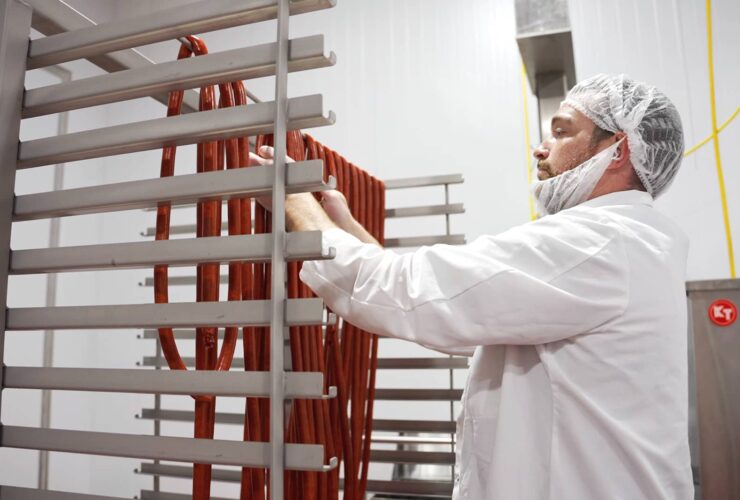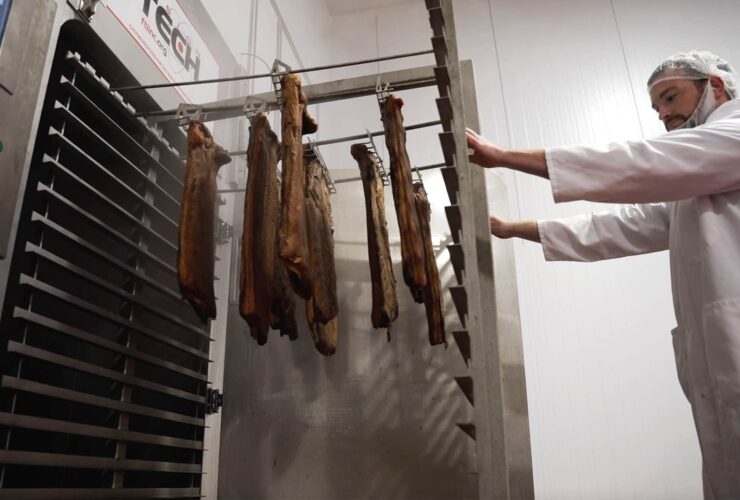Airflow is the most important feature of any industrial smokehouse or dehydrator.
It’s the airflow that is ultimately responsible for creating the breakpoint that in turn cooks product in the oven. The better the airflow, the stronger the breakpoint, and the more consistently product will cook — resulting in better yields, better coloring, and better texture.
The airflow is critically important to any cooking process, which means it’s critically important to be aware of any variations in airflow that may affect the creation of the breakpoint and result in inconsistent cooking.
But how do you do that? How do you know if the air is moving optimally in an oven? How can you determine if something is wrong with an oven and affecting the airflow?
The answer is simple.
Regularly perform these 4 calculations to determine the health of airflow in your smokehouse.
Airflow Calculations
The following airflow calculations will give you a snapshot into the health of the airflow in your oven, and help you determine if there’s a maintenance or critical failure issue that needs to be addressed.
It’s recommended to perform these calculations on a consistent basis so variations are caught early and limit the impact to your product.
Air Velocity Readings
Calculation:
Average of the high and low air velocities measured at the cones or slots (in fpm)
The first calculation is really a simple reading. Using a velometer, measure the velocity of the air exiting the air cones or slots at both high velocity and low velocity.
Depending on the style of your oven, this will either be:
- Under the same cone/slot (constantly rotating dampers)
- Under cones/slots on opposite sides of the oven (dampers that can be stopped and held in one place)
Write down both the high-velocity and low-velocity readings, as they will be used in further calculations.
Example:
- Average High Velocity = 5262 fpm
- Average Low Velocity = 2375 fpm
Recirculating Air Volume
Calculation:
Air velocity (defined as high velocity + low velocity) x supply area
The recirculating air volume calculation will tell you the amount of cfm that is moving in your oven — and is needed to determine the air flow rate, which is the calculation you will use to determine the health of airflow in your oven.
In order to perform this calculation, you need to determine the supply area in square feet of your cones or slots — a calculation you only need to perform once as the cones or slots should not change in your oven.
Here’s how you determine the supply area:
- Cones: Number of cones x the supply area of each cone (supplied by the manufacturer) = total supply area
- Slots: Width of slot in inches x length of slot in inches = square inches
- After determining the square inches of the slots, you need to convert them to square feet. You can either use an online converter or use this formula: square inches x 0.00694444 = square feet
Once you have the supply area, determining the recirculating air volume is easy! Add the high-velocity and low-velocity numbers from the first calculation, and multiply the answer by the supply area in square feet. That will give you the cfm of air volume.
Example:
- Supply Area:
- 60 cones x .0218 sq ft / cone = 1.308 sq ft
- 1.25″ wide slot x 151″ long slot = 188.75 sq inches x 0.00694444 = 1.308 sq ft
- Recirculating Air Volume:
- (5962 fpm + 2375 fpm) x 1.308 sq ft
- Answer = 10,905 cfm
Oven Volume
Calculation:
(Inside Width (in inches) x Inside Length (in inches) x Inside Height (floor to return duct bottom) (in inches)) / 1728
Knowing the volume of air your oven holds is necessary in order to determine the airflow rate. It’s a simple volume calculation to get the volume in cubic inches and then divide by a constant to get the cubic feet.
Example:
- 116″ inside width x 159″ inside length x 90″ floor to return duct height = 1,659,960 cubic inches
- 1,659,960 cubic inches / 1728 (number of cubic inches in 1 square foot)
- 960 cubic feet of volume
Air Flow Rate:
Calculation:
Recirculating Air Volume / Oven Volume
The air flow rate in an oven is the determining factor for oven health — if this number changes drastically, something is wrong with the oven — and is good to know for cooking various product.
Once the other three calculations have been performed, you can easily determine the air flow rate (air changes per minute) of your oven by taking the recirculating air volume (calculation 2) and dividing it by the oven volume (calculation 3).
This will give you the number of air changes per minute happening in your oven and can be adjusted to fit your product and used to monitor any broken areas in the oven.
Example:
- 10,905 cfm (recirculating air volume) / 960 cubic feet (oven volume)
- 11.36 air changes per minute
Why is Air Flow Rate Important?
The air flow rate in an oven has two main uses:
- Determining if there is an issue in the oven
- Adjusting to better cook your product
Issues in the Oven
The airflow in the oven should stay more or less constant. There will always be small variations that just happen, but large variations are often a sign that something is wrong in the oven — like the dampers are out of alignment, or the fan isn’t functioning correctly.
Calculating and recording the Air Flow Rate on a consistent basis will give you a snapshot of the health of your oven, and help you notice any issues early on, especially in areas of the oven that aren’t inspected or seen on a daily basis.
Adjusting for Product
Differing products and differing desired results require a different air flow rate. Because the airflow ultimately cooks your product, it makes sense that adjusting the air flow rate will change the way the product is cooked.
Products like dry and semi-dry sausage require less air changes than fast-drying and heating-stable products.
The following is a good industry rule of thumb for the air flow rate needed:
- Low (3-9 air changes) = dry and semi-dry sausage
- Medium (9-15 air changes) = most commonly used for a wide variety of products
- High (15-20 air changes) = stable products that require fast drying and heating
Become an Airflow Expert
Airflow is the most important feature of your industrial smokehouse or dehydrator — so understanding the airflow, how it creates the breakpoint, and how it cooks and affects your product is essential for producing consistent results.
We’ve compiled a guide to help you understand the breakpoint and how controlling it (or the lack of control) affects your product, both positively and negatively. Click the banner below to download a copy and become an airflow expert!




